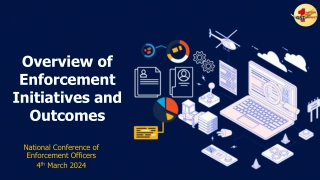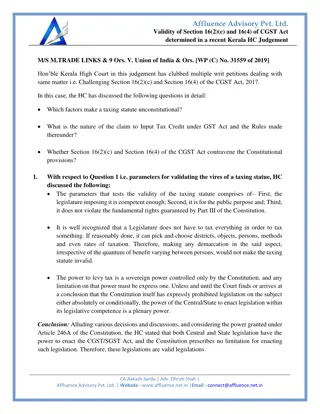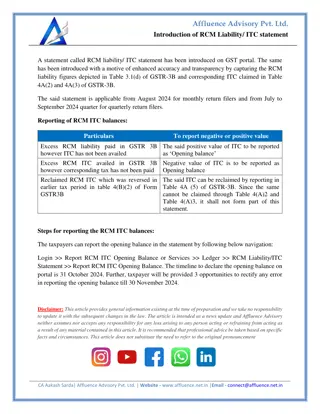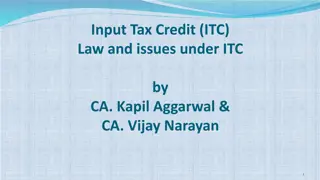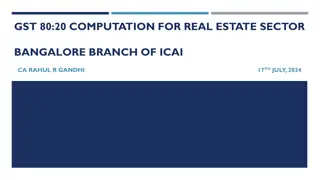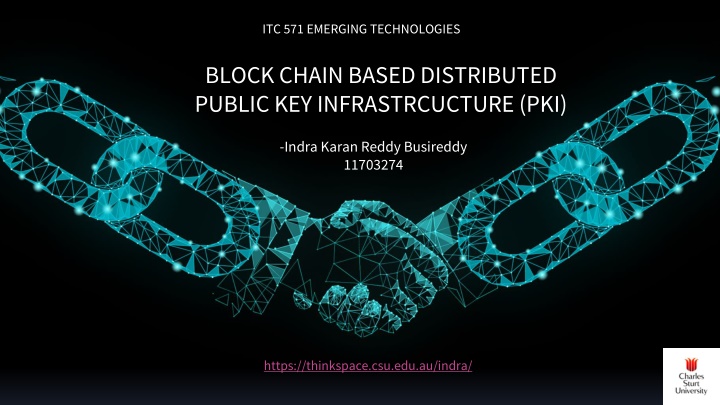
Implementing Blockchain-Based PKI for Enhanced Security
Explore the integration of blockchain technology with Public Key Infrastructure (PKI) to decentralize operations and improve security. Dive into key characteristics, advantages, and challenges of blockchain implementation, along with various approaches like Emercoin Name Value Service (NVS) and Ethereum smart contracts. Discover the potential of blockchain to revolutionize data storage and transmission across industries.
Uploaded on | 0 Views
Download Presentation

Please find below an Image/Link to download the presentation.
The content on the website is provided AS IS for your information and personal use only. It may not be sold, licensed, or shared on other websites without obtaining consent from the author. If you encounter any issues during the download, it is possible that the publisher has removed the file from their server.
You are allowed to download the files provided on this website for personal or commercial use, subject to the condition that they are used lawfully. All files are the property of their respective owners.
The content on the website is provided AS IS for your information and personal use only. It may not be sold, licensed, or shared on other websites without obtaining consent from the author.
E N D
Presentation Transcript
ITC 571 EMERGING TECHNOLOGIES BLOCK CHAIN BASED DISTRIBUTED PUBLIC KEY INFRASTRCUCTURE (PKI) -Indra Karan Reddy Busireddy 11703274 https://thinkspace.csu.edu.au/indra/
Whats Today? Introduction Literature Review Results Conclusion Reflection References
Introduction This current research paper addresses the various approaches, issues and challenges involved during the implementation of Blockchain technology in Public Key Infrastructure. Block chain technology is integrated with the existing PKI to decentralise the noded operations. Integrating PKI with blockchain and analyse different approaches. Different applicable industries like IoT, Big data are identified for implementation.
Introduction (Contd) Key characteristics of blockchain implementation include decentralized and distributed framework. Blockchain is private and secured to use avidly in various sectors. As the data is stored in blocks and addressed with identity hashtags, the stored data is tampering free. Relevant information of various approaches, algorithms, issues is collected from trusted journals, articles and other sources for the research.
Literature Review The various approaches involved for the implementation of PKI with blockchain are studied. Various advantages of the implementation are known during the research. Performance, Security, Privacy, Complexity and Scalability issues are highlighted. Blockchain technology is being avidly used to address these issues with different approaches. These approaches include Emercoin Name Value Service (NVS), smart contracts by Ethereum blockchain, and Ethereum Light Sync client.
Literature Review (Contd) Key aspects of the approaches to implement block chain are discussed in detail. Obtained results during he research are discussed in detail. The proposed systems from the research papers are studied and analysed to what extent they are applicable comparing with the existing system overcoming the issues being currently faced. Future scope of applying Block chain based PKI across multiple industries are discussed.
Results Through the research on various journals and articles it can be said as blockchain as a emerging technology has a huge scope to be applied across various industries and sectors. The traditional PKI limited advantages and applications due to various concerning issues. Blockchain supports the traditional PKI with additional possessing features by improving the operational capacity and security. Blockchain with its decentralised network offers uninterrupted services with huge & safe, data storage & transmission.
Results (Contd.) The framework of blockchain is so rigid that it cannot be disturbed or destructed. This rigidity of block chain prevents the information amd system being attacked by malwares, trojans etc.., keeping the sensitive data secured. IoT, Big Data and Cybersecurity are the sectors for the avid use of blockchain. Services and sectors which deal with real time data have integrated their applications with block chain for secured storage and transmission of information.
Reflection This unit had helped me to improve my research skills choosing a research scoped topic through a detailed study and analysis on various published papers. The concept and working scenario of Blockchain technology had attracted me to conduct an in detail research during the initial study. Various research methodologies are followed to understand the concepts, challenges, issues involved for the implementation of block chain technology in different scenarios. Various block chain applications are studied which are implemented across multiple disciplines.
References Axon, L. M., & Goldsmith, M. (2016). PB-PKI: A privacy-aware blockchain-based PKI. Conoscenti, M., Vetro, A., & De Martin, J. C. (2016, November). Blockchain for the Internet of Things: A systematic literature review. In 2016 IEEE/ACS 13th International Conference of Computer Systems and Applications (AICCSA) (pp. 1-6). IEEE. Hepp, T., Spaeh, F., Schoenhals, A., Ehret, P., & Gipp, B. (2019, April). Exploring Potentials and Challenges of Blockchain-based Public Key Infrastructures. In IEEE INFOCOM 2019-IEEE Conference on Computer Communications Workshops (INFOCOM WKSHPS) (pp. 847-852). IEEE. Jiang, W., Li, H., Xu, G., Wen, M., Dong, G., & Lin, X. (2019). PTAS: Privacy-preserving thin-client authentication scheme in blockchain-based PKI. Future Generation Computer Systems, 96, 185-195. Kubilay, M. Y., Kiraz, M. S., & Mantar, H. A. (2019). Certledger: A new pki model with certificate transparency based on blockchain. Computers & Security, 85, 333-352. Lewison, K., & Corella, F. (2016). Backing rich credentials with a blockchain PKI. Pomcor. com.
References (Contd) Orman, H. (2018). Blockchain: The emperors new PKI?. IEEE Internet Computing, 22(2), 23-28. Sharma, T., Satija, S., & Bhushan, B. (2019, October). Unifying Blockchian and IoT: Security Requirements, Challenges, Applications and Future Trends. In 2019 International Conference on Computing, Communication, and Intelligent Systems (ICCCIS) (pp. 341-346). IEEE. Singla, A., & Bertino, E. (2018, October). Blockchain-based PKI solutions for IoT. In 2018 IEEE 4th International Conference on Collaboration and Internet Computing (CIC) (pp. 9-15). IEEE. Wibowo, S., & Sandikapura, T. (2019, November). Improving Data Security, Interoperability, and Veracity using Blockchain for One Data Governance, Case Study of Local Tax Big Data. In 2019 International Conference on ICT for Smart Society (ICISS) (Vol. 7, pp. 1-6). IEEE. Yakubov, A., Shbair, W., Wallbom, A., & Sanda, D. (2018). A blockchain-based pki management framework. In The First IEEE/IFIP International Workshop on Managing and Managed by Blockchain (Man2Block) colocated with IEEE/IFIP NOMS 2018, Tapei, Tawain 23-27 April 2018. Yli-Huumo, J., Ko, D., Choi, S., Park, S., & Smolander, K. (2016). Where is current research on blockchain technology? a systematic review. PloS one, 11(10), e0163477.

